Feel free to download and use them, under the condition that you provide a proper reference (given below).
|
|
(link to a movie) |
|
|
|---|---|---|---|
|
Compression An aggregate made via particle-cluster aggregation (PCA), of porosity 85%, is being compressed between two surfaces. This aggregate is composed of 298 spherical SiO2 monomers 0.6μm in radius. Paszun, D. & Dominik, C. 2008, Astronomy and Astrophysics 484, 859 |

|
=> => => |
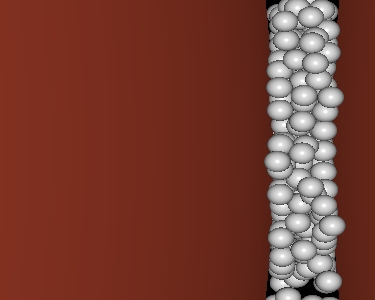
|
|
Reference for movies below:
|
|||
|
Collisional compression (0.5 m/s impact) PCA aggregates made of 200 monomers each collide at 0.5 m/s. Energy is dissipated on restructuring of both particles. The rolling is a main dissipation chanel. |
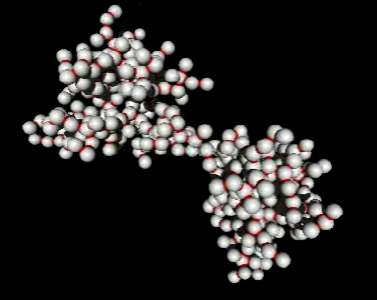
|
=> => => |
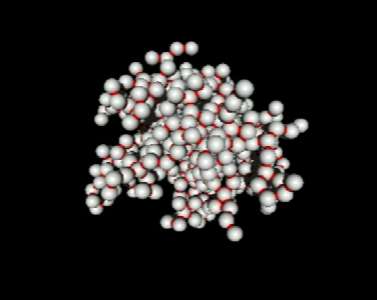
|
|
Collisional compression (0.75 m/s impact) PCA aggregates made of 200 monomers each collide at 0.75 m/s. Energy is dissipated on restructuring of both particles. The rolling is a main dissipation chanel. Erosion sets in and a few monomers are lost. |
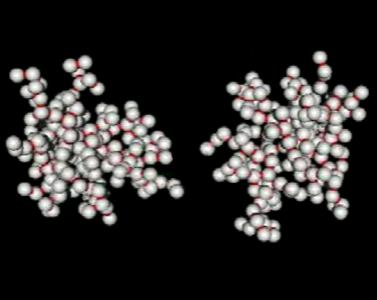
|
=> => => |
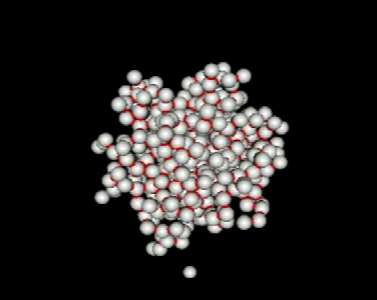
|
|
Maximum compression (1 m/s impact) PCA aggregates made of 200 monomers each collide at 1 m/s. Energy is dissipated on restructuring of both particles. Maximum compression is reached. Every increase of the impact energy causes more damage and stronger erosion. |
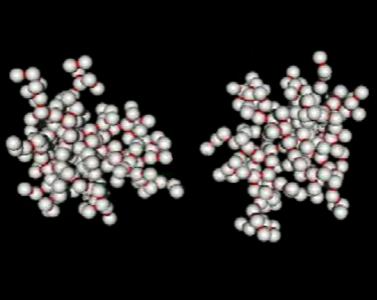
|
=> => => |
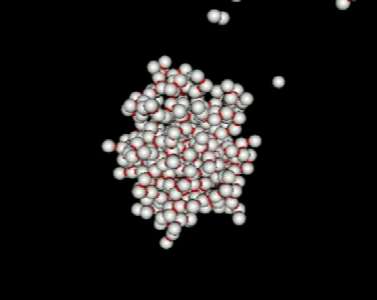
|
|
Compression / decompression (2 m/s impact) PCA aggregates made of 200 monomers each collide at 2 m/s. Energy is dissipated on restructuring of both particles. Maximum compression is reached. There is however energy left and more restructuring leads to flattening. Every increase of the impact energy causes more decompression (flattening) and stronger erosion or even fragmentation. |
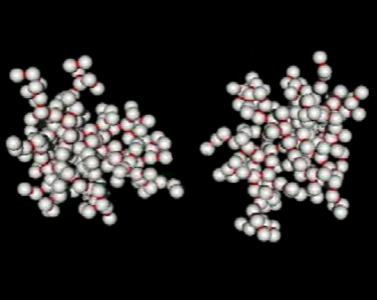
|
=> => => |
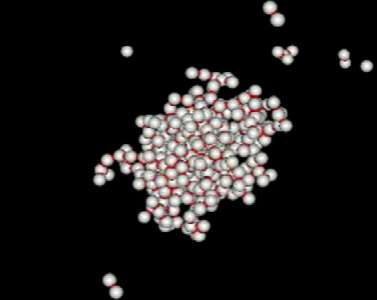
|
|
Off-set collision (0.75 m/s impact) PCA aggregates made of 200 monomers each collide at 0.75 m/s. The impact parameter is in this case equal to 1.5 aggregates radii. Energy is dissipated on restructuring of both particles. However, monomers are rolled out of each other rather than closer in. Reulting aggregate is stretched and thus very fluffy. |
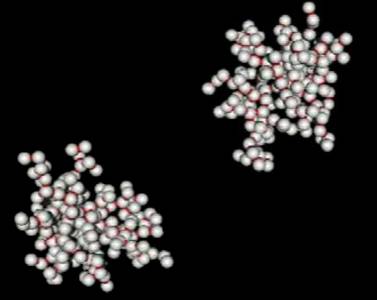
|
=> => => |
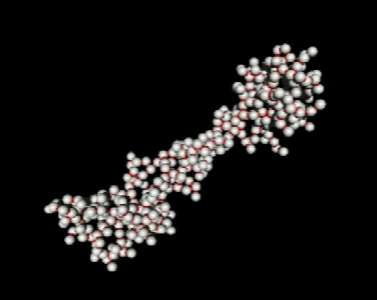
|
|
Off-set collision (1 m/s impact) PCA aggregates made of 200 monomers each collide at 1 m/s. The impact parameter is in this case equal to 1.5 aggregates radii. Energy is dissipated on restructuring of both particles. At this point however resulting aggregate is composed of two impactors connected by a string of monomers. Very elongated structure forms due to the large impact parameter. An increase of the impact energy, however, causes break of the string-bond. |
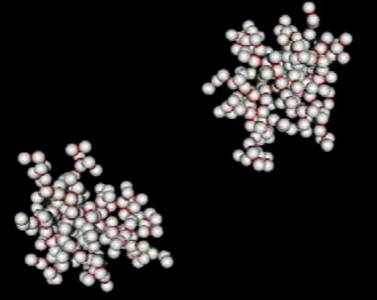
|
=> => => |
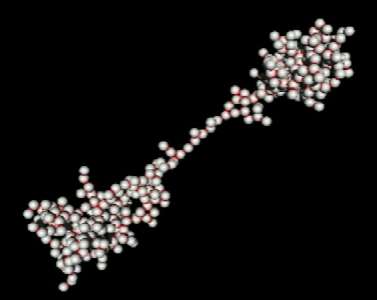
|
|
Central collision of two fractal aggregates of different mass (2 m/s impact) The fractal dimension of each aggregate is Df=2.2. The target aggregate is composed of 1000 monomers, while the projectile has 50 monomers. The small projectile penetrates the fluffy target. Although the relative velocity is 2m/s, the energy per particle is only about 25% of the energy needed to roll one monomer over another by 90 degrees (Eroll). Note high flufiness and resulting from that inefficient energy transfer (some fragments stay intact in their original positions mening that they do not /"feel/" the impact). |
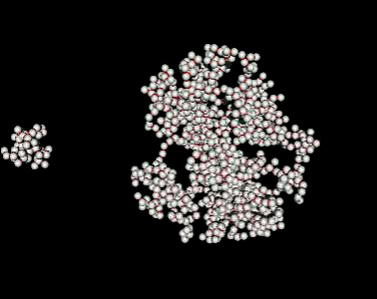
|
=> => => |
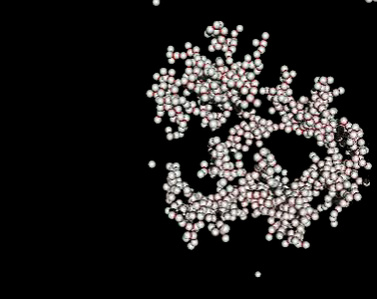
|
|
Central collision of two fractal aggregates of different mass (2 m/s impact) The fractal dimension of each aggregate is Df=2.2. The target aggregate is composed of 1000 monomers, while the projectile has 200 monomers. The small projectile penetrates the fluffy target. Although the relative velocity is 2m/s, the energy per particle is only about 75% of the energy needed to roll one monomer over another by 90 degrees (Eroll). Note high flufiness and resulting from that inefficient energy transfer (some fragments stay intact in their original positions mening that they do not /"feel/" the impact). |
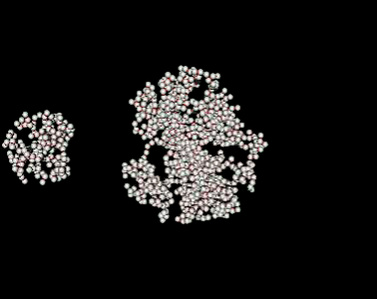
|
=> => => |
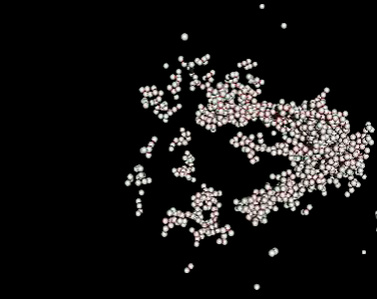
|
|
Central collision of two fractal aggregates of different mass (2 m/s impact) The fractal dimension of each aggregate is Df=2.2. The target aggregate is composed of 1000 monomers, while the projectile has 400 monomers. Although the relative velocity is 2m/s, the energy per particle is only about 1.1 of the energy needed to roll one monomer over another by 90 degrees (Eroll). Note high flufiness and resulting from that inefficient energy transfer (some fragments stay intact in their original positions mening that they do not /"feel/" the impact). |
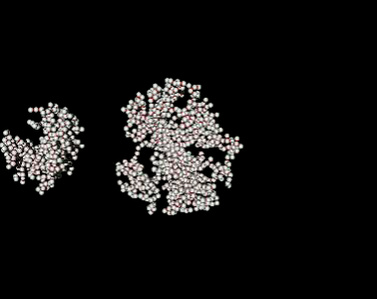
|
=> => => |
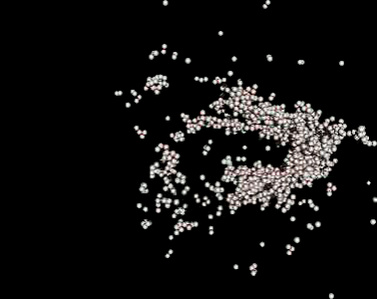
|
|
Central collision of two fractal aggregates of different mass (2 m/s impact) The fractal dimension of each aggregate is Df=2.2. The target aggregate is composed of 1000 monomers, while the projectile has 800 monomers. Although the relative velocity is 2m/s, the energy per particle is only about 1.3 of the energy needed to roll one monomer over another by 90 degrees (Eroll). Note high flufiness and resulting from that inefficient energy transfer (a few fragments stay in their original positions mening that they do not /"feel/" the impact). |
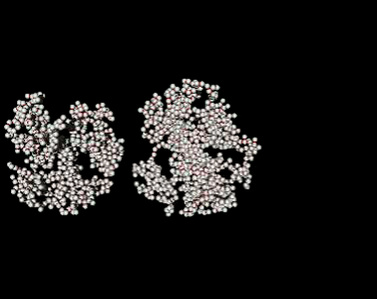
|
=> => => |
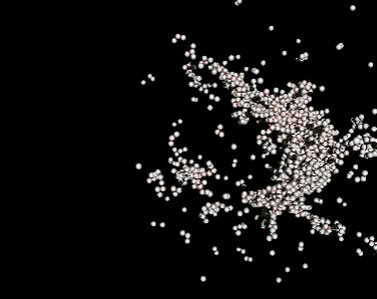
|
|
Central collision of two fractal aggregates of different mass (25 m/s impact) The fractal dimension of the bigger aggregate is Df=2.9, while for the smaller one it is Df=2.5. The target aggregate is composed of 104 monomers, while the projectile has only 100 monomers. The very high impact velocity translates to energy of 8.3 of the rolling energy Eroll, per monomer. This is sufficient to erode the target aggregate. However about 90% of the total mass still remains in the largest fragment. The resulting aggregate has a big crater, however, its mass is strongly compressed. |
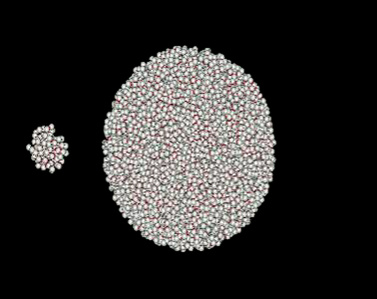
|
=> => => |
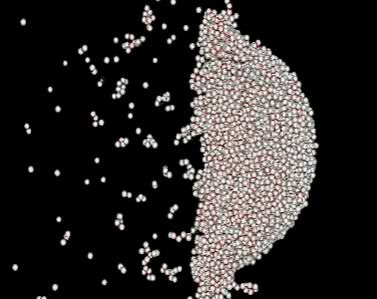
|
|
Chondrule analog impact onto a dust cake (1 m/s impact) PCA aggregates made of ~1800 monomers is impacted by a big grain at 1 m/s. The aggregate has a /"bottom/" - a solid surface simulated by a very big grain. The chondrule penetrates the aggregates and forms a intrusion tunel. This small number of particles, however, is insufficient for this simulation. To be updated. |
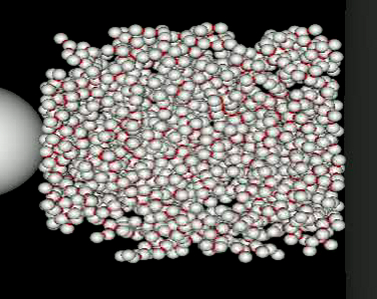
|
=> => => |
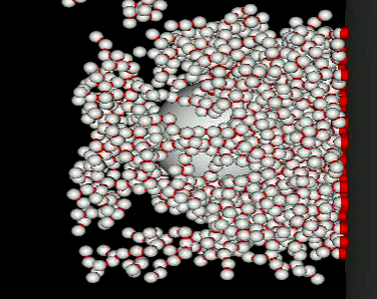
|
|
Collision of two aggregates made of a monomers of two different sizes: 1μm and 0.1μm (1 m/s impact) Although 1m/s impact is below fragmentation threshold for aggregates made of a monodisperse distribution (for both monomer sizes), these aggregates are shattered. This shows that size distribution of monomers makes the aggregates weaker.To be updated. |
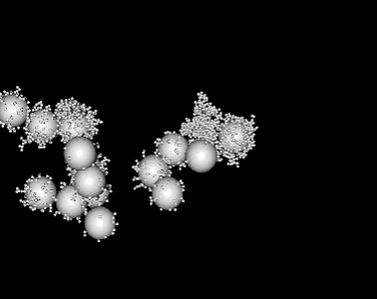
|
=> => => |
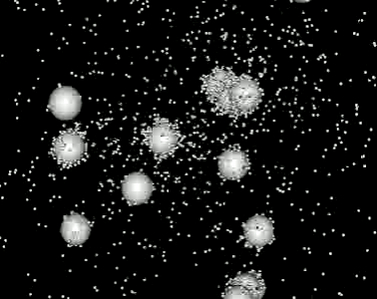
|
|
Ice aggregates collision (8 m/s impact!) PCA aggregates made of 200 monomers each collide at very high velocity. The sticky nature of ice prevents disruption. Aggregates are strongly compressed, however, no monomer is lost. The erosion regime is not yet reached. |
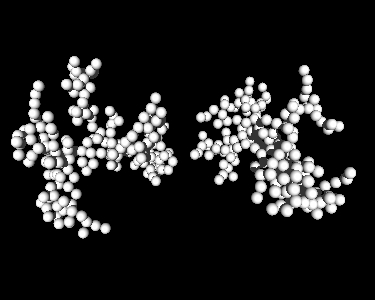
|
=> => => |
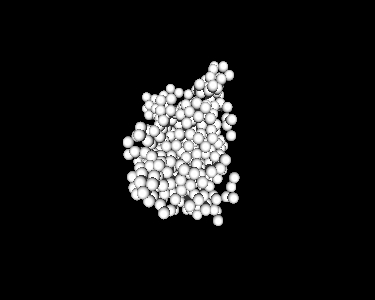
|